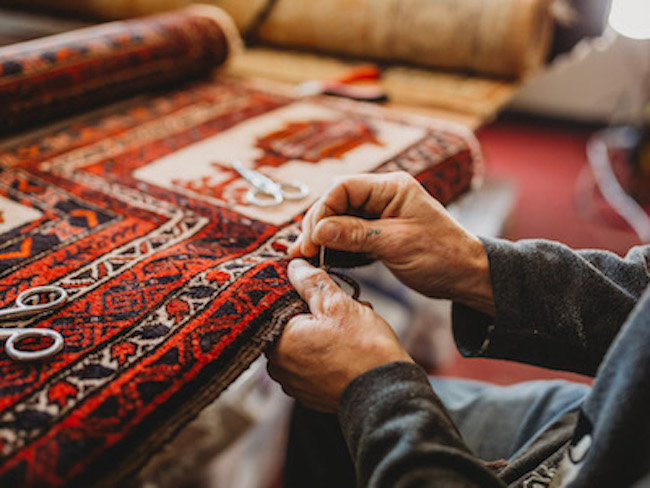“It’s a big difference between taking an extraction cleaner to the surface and totally submerging it,” he said. “I’ve been cleaning rugs for 40 years, but I’ve been washing them for about nine.”
The actual washing is done in a 1,200-gallon tub, but that’s just one part of an exhaustive process Brant and his team put each rug through to ensure it comes out the other side even more beautiful than you realized it could. Step one involves taking that basic vacuuming you do to the next level. Utilizing a specialized air compressor, the team blasts air through the rug onto an outdoor grate, controlling the pressure with skill to avoid damage to the rug.

Long known for his home cleaning and disaster recovery services, Gerald Brant of Lowcountry Clean Care is a dyed-in-the-wool expert when it comes to rugs.
“After we vacuum, we’ll flip them over and you can see all the sand filtered out under the grating,” Brant said. “That doesn’t mean it’s a quick process; people wouldn’t believe it, but we can spend two hours blowing out a rug.”
The next step takes them into the tub, where the rugs are soaked in a specialized solution for a deep clean. “I wash them like laundry—lights, darks, pastels, deep reds … I call it washing, but they’re really just swimming for about an hour,” he said. The tank’s baffles slowly run across the surface, keeping water circulating through the rugs as they float. Another high-tech option is a massive centrifuge which runs 18 feet inside their Hampton facility. “We’ll turn that on and spin them, and we can also spray and rinse while they’re turning.”
From there, the rugs are hung out to dry, preferably outdoors as weather permits, on specially built racks designed to eliminate creases.
This is a very simplified way of describing a very complicated process, but suffice it to say, it’s the only way to get rugs truly clean. “We don’t just take the rugs back run a vacuum over them, throw them in a tub and bring it back to you. There’s a lot more to it than that,” Brant said. “If a person could see the journey their rug goes through, they’d tell me I don’t charge enough.”
And that’s just what they can do to get rugs clean. Backed up by Brant’s knowledge as a certified Master Rug Cleaner, Lowcountry Clean Care can handle even the worst repair jobs, from missing fringe to worn patches. And it’s all done with dedication to the craft “We don’t even own a sewing machine,” Brant said. We do all of our repair work by hand. It takes time.”
That’s in addition to using a process that corrects overdyed rugs or rugs whose dye has run and makes colors pop using a specialized solution. “You ought to see some of these rugs when they come out, how bright and vibrant they are.”
While Lowcountry Clean Care has been around for 40 years, offering general cleaning services as well as disaster recovery, it was their move to the expanded Hampton facility in the summer of 2011 that allowed them to go all in on washing rugs. Perhaps most impressive beyond its size is its commitment to the environment. A sophisticated rainwater collection system provides for a good portion of their water needs, piped in from the roof and thoroughly cleaned.
“During a good hard rain, we can get 1,000 gallons per inch of rain,” he said. “Right now, we have about 1,500 gallons in each of our three tanks.”
And with that water, the team can clean upward of 50 rugs a week. “You have to have support staff,” Brant said, singling out full-time employee John Moseley as the linchpin of the operation. “He’s been an integral part of this business and is someone I hope to see take over for me somewhere down the road.”
To see the massive difference between cleaning and washing yourself, drop your rug off at either Clothes Press location on Hilton Head Island, at Door 2 Door Dry Cleaning Service or Gilman Floors in Bluffton, or at FWDG in Beaufort. Otherwise, Lowcountry Clean Care is happy to come to you to pick up your rug.
Check out www.lowcountrycleancare.com or like them on Facebook to see videos of the cleaning process and to learn more.




